

Order confirmations, account notifications, password reset emails — these are all transactional email examples. Often overlooked, transactional email is vital to maintaining customer relationships and driving repeat business.
Picture this: You buy a brand new laptop for $2000.00, but receive nothing in your inbox. No order confirmation, no payment receipt — just crickets.
Panic sets in. You start to wonder if you’ve been scammed. That’s the last time I’m buying from them, you tell yourself.
This kind of unpleasant situation highlights the importance of transactional email.
Because even minor errors or delays with your transactional emails can cause a massive loss of trust among your customers, potentially making them not want to come back.
Now that you’ve an idea of how essential these email messages are to your ecommerce business, let’s take a deeper look at them. In this guide, you’ll learn about:
- Transactional email definition
- Transactional emails vs marketing emails
- Transactional email examples
- How to set up transactional emails
- Transactional email best practices
- Transactional email design
- How to leverage transactional email marketing
What is a transactional email?
Transactional email definition
A transactional email is an email that’s automatically sent by your website to an individual recipient following a transaction or specific action performed by that person, such as an ecommerce purchase or a password reset request.
What qualifies as a transactional email?
All emails that are sent automatically and instantly following a specific action or event on your website can be considered ‘transactional’. Common examples include:
- Subscription confirmation (or double opt-in)
- Order confirmation
- Notification emails (delivery updates, new message, etc.)
- Password reset emails and account notifications
- Bills, receipts, etc.
Transactional emails vs marketing emails: What’s the difference?
Transactionals emails are not the same as marketing emails. Transactional emails fulfill the customer communication needs that are necessary to business operations. Marketing emails, sent to an audience of email subscribers, serve to promote and inform.
While marketing emails are important for growing your brand and revenue, their absence doesn’t affect your core business or website functionality.
Different sending process
The main difference between transactional emails and marketing emails (i.e. newsletters or promotional emails) is that transactional emails are sent after being triggered by a transaction or event on your site.
These personalized one-to-one communications contain information specific to the transaction that just took place.
Email marketing, on the other hand, is when you send a promotional message to a list of contacts, i.e. a ‘one to many’ communication. Here, we’re talking about an email campaign — or series of emails — pre-planned and sent at the time of your choosing.
Are abandoned cart emails transactional?
No. Abandoned cart emails, triggered whenever a customer abandons a cart on an ecommerce site, are not transactional. These are marketing emails. The recipient has to be already subscribed to your email marketing list. Which brings us to the next point…
Email subscription requirements
Unlike transactional emails, marketing emails are sent to email subscribers only. If you want to send a marketing email to someone, that person needs to have opt-ed in to receive promotional emails from you.
If they’re not subscribed to your email list, then you have no right to contact them. And doing so could very easily put you in hot water with data protection laws like the GDPR and CAN-SPAM act.
All marketing emails need to have an unsubscribe button allowing subscribers to opt out at any time.
Do transactional emails need an unsubscribe button?
No, because transactional emails do not require the recipient to be subscribed to your email list in the first place.
As these are one-off emails relating to a specific transaction, the recipient can expect to not receive any more emails from you in the future (or at least until their next purchase).
You can, of course, offer the option to join your mailing list at the checkout. But remember, just because someone gave you their email address as part of the transaction, you’ve no right to send them marketing emails without their consent.
Different emailing software
An important point to note when choosing emailing tools for your business: Transactional emails have different software requirements to marketing emails.
Because of their automated and instantaneous nature, transactional emails are sent over a dedicated SMTP server or transactional email API. This is done to ensure the best possible email deliverability.
Using one tool for all emails
If you’d like to be able to centralize all your emails in one solution, some email marketing services like Sendinblue cater for both marketing and transactional emails.
Some marketers prefer to have both types of email under the one roof as it’s less hassle than managing two different subscriptions. Not to mention that it can also work out cheaper too.
Test-drive Sendinblue’s transactional email serviceFree SMTP server for up to 300 emails/day, email API for developers, transactional email templates, and more. |
Transactional email examples
What are the different types of transactional emails?
Transactional email examples come in many different forms but with one thing in common: Important information your customers or website visitors need in order to interact normally with your business.
To give you a better idea, here are a few of the different types of transactional email messages you might set up for your own site (or come across in the wild):
Account creation or email subscription confirmation
Sent after a user creates an account or subscribes to a newsletter, this type of transactional email typically serves as a means of verifying a new customer’s email address.
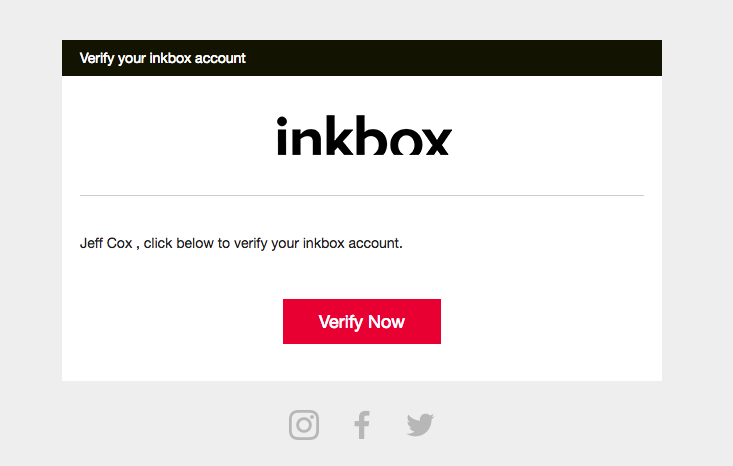

You can use this type of email for new users if you have user accounts through your site, or you can use it to confirm your contacts’ newsletter subscriptions through a double opt-in process.
Be careful not to confuse the account or subscription confirmation email with the welcome email. This serves more of a marketing purpose and can be sent with simple email autoresponder software.
Order confirmation
This is without a doubt the transactional email that your clients anticipate the most. If you sell online, it’s essential that you send an order confirmation to ensure a positive customer experience.
Order confirmation emails have several objectives:
- Confirm the price and items that were purchased
- Reassure the customer that the purchase went through
- Provide all the necessary information for keeping track of the order (order number, package tracking number, customer service contact details, etc.)
- Give an estimated delivery date
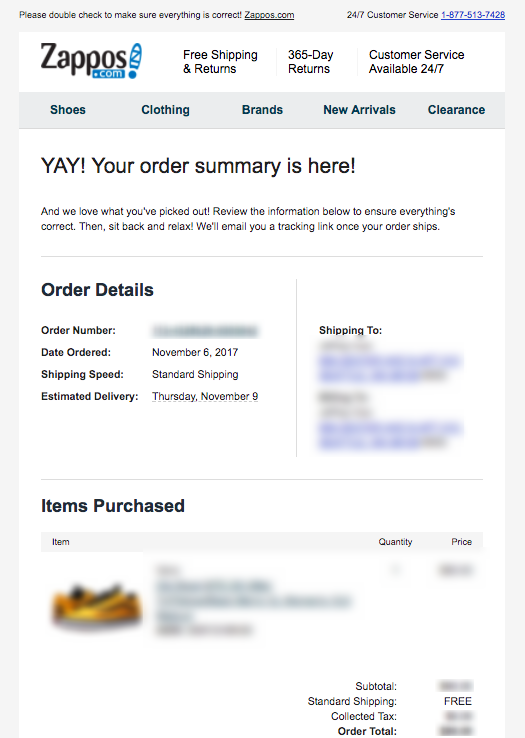

Consumers often worry there were problems with their order or billing information. This email alleviates any concerns by confirming the exact amount that was charged and listing all the items that were purchased.
This is especially important for customers who don’t usually shop online. That’s why you’ve got to make sure your order confirmation emails are set up to provide all the necessary details and put customers at ease.
Order follow-up
Customer communication doesn’t have to stop at the order confirmation email. In fact, it’s important that you continue to follow up with customers so they know exactly what’s going on with their order.
To keep customers in the loop, you can send transactional email notifications for the various steps in the delivery process:
- Order preparation
- Shipping confirmation
- Delivery confirmation
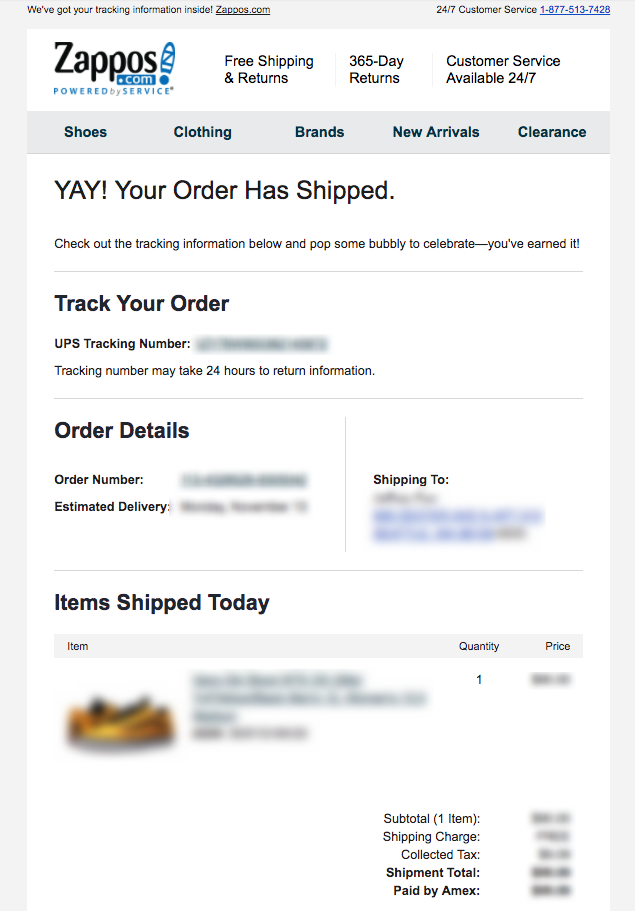

While you may not need to send transactional emails for all these scenarios, you should at least send shipping confirmations. This way customers know that it’s been sent out, can track their shipment, and be on the lookout on delivery day.
These notifications are especially important if you’re running a Click and Collect service.
Bills and receipts
Receipts or bills can sometimes be integrated directly into the order confirmation email, but occasionally, websites dedicate a separate transactional email for this message as well.
This is usually the case for:
- Businesses that don’t deliver a physical product
- Subscription style payments that require regular receipts
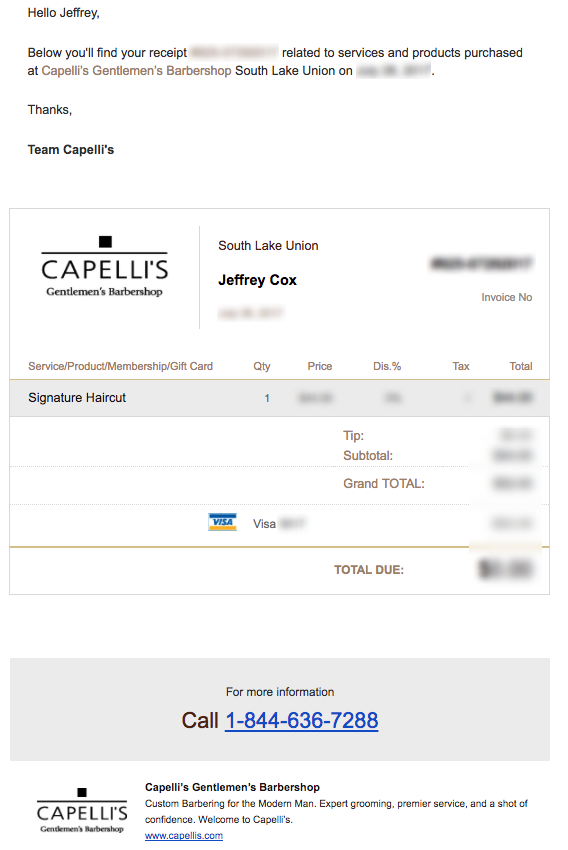

Sending bills and receipts are important because they provide complete transparency to customers on how much (and how frequently) they’re being charged.
It’s also important for record keeping — so keep your customers happy and provide them with the receipts they need.
Password reset
Password reset emails might be the least glamorous of the transactional emails, but they’re crucial to providing a positive user experience on your website.
Their purpose is pretty self-explanatory: they allow users to reset their passwords when they’ve forgotten their previous login credentials.
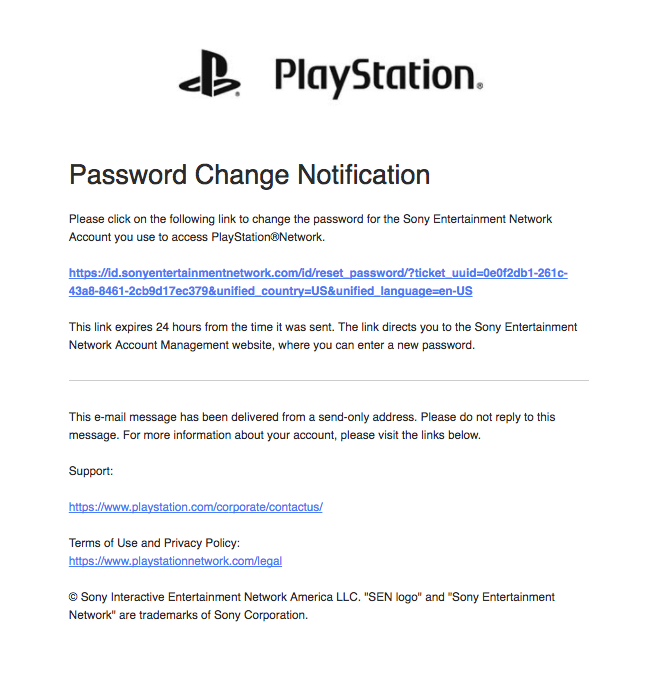

Make sure you’ve got a properly functioning password reset transactional email. Without it, users who forget their password will have no way to get back into their account and interact with your business.
How to set up transactional emails
Transactional emails are sent over SMTP (Simple Mail Transfer Protocol), an internet protocol for transmitting emails over the internet. And they require a special type of solution to ensure reliable and consistent deliverability.
Use a dedicated and reliable SMTP solution
The best option for successfully managing your transactional emails is to use a dedicated transactional email service like Sendinblue.
Although most ecommerce CMS (Woocomerce, Prestashop, Magento, etc.) provide default transactional emails out of the box, these generic options are limited when compared with dedicated solutions like Sendinblue.
Using a specialized tool lets you:
- Follow real time analytics for email deliverability and engagement
- Personalize your transactional email templates for better branding, design, and user experience
- Ensure optimal deliverability for all of your messages
If you only use your default CMS’ transactional emails, you’ll most likely be left with your fingers crossed, hoping your emails were delivered successfully.
Set up your emails with Sendinblue’s transactional email service
To get transactional emails up and running for your site using Sendinblue, you have 3 options:
- Use one of our plugins that connects your CMS with Sendinblue (such as our WooCommerce plugin)
- Configure your SMTP settings manually through Sendinblue
- Use our email API: read the API documentation here
Note that the second and third options will require programming skills or the assistance of a developer.
Developers can also check out our guide to setting up transactional emails with Next.js and Sendinblue.
If you don’t have access to a developer, your best bet is to find the right plugin to make setup much simpler.
Transactional email best practices
Separate your transactional emails and your promotional marketing emails
Choose a solution that lets you separate the routing of your transactional emails from that of your promotional email campaigns.
As mentioned earlier, transactional emails serve a very specific and vital purpose.
You don’t want your transactional emails to suffer because of the inevitably lower deliverability and engagement of your marketing emails. Transactional emails need to land in the inbox on time, every time.
One problem with an email marketing campaign can damage your sender score. This can eventually affect the deliverability of your future emails. You want to avoid letting these types of problems impact your transactional emails at all costs.
With Sendinblue, you can:
- Separate your marketing and transactional email streams (by sender and IP address)
- Manage and follow the performance of all of your emails from one account
- All at no additional cost!
Transactional email design
Personalize your transactional email templates with your brand colors
Most transactional emails are pretty bland and unengaging. Why not make them more attractive and recognizable using the colors of your brand?
On Sendinblue, you can edit your transactional emails using any one of several email templates available in the design template library.
The simple act of adding your logo and a few links back to your site can make a big difference in the marketing ROI you get from these messages.
Here’s an example of an order confirmation template that you can customize for your own use in Sendinblue:
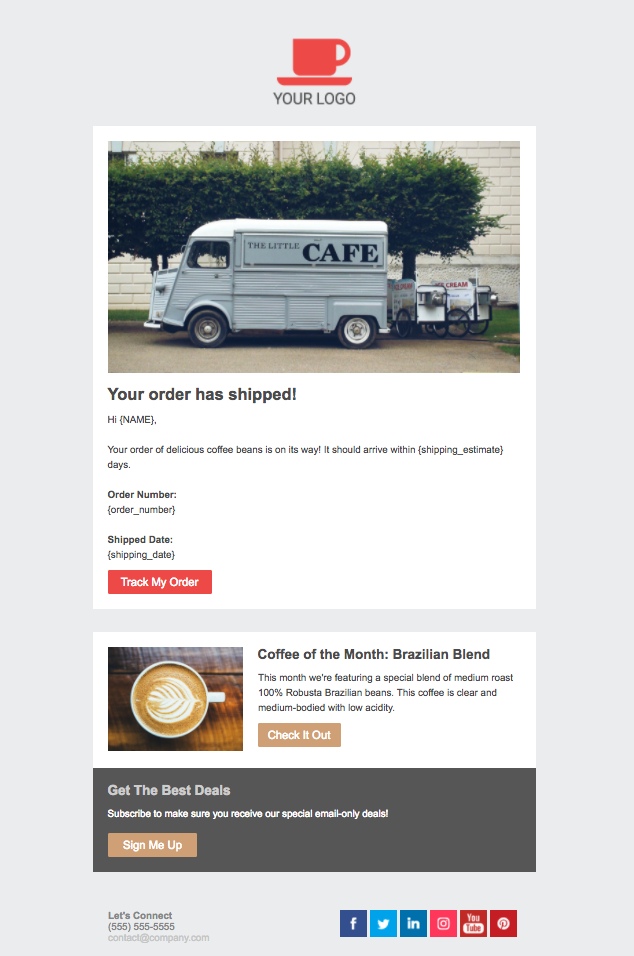

How to leverage transactional email marketing
As we’ve mentioned a few times in this article, the main purpose of transactional messages is functionality. It’s about communicating important information to the customer at the right time.
But, transactional emails also represent a massive marketing opportunity for brands who are willing to invest time in developing this digital real estate.
Why exactly do transactional emails have so much marketing potential?
Unlike regular promotional emails, sent at the discretion of marketers or business owners, transactional emails are sent automatically and are expected by customers.
It’s no surprise really that an Experian study found transactional emails had open rates 8 times higher those of marketing emails.
Despite these incredible engagement rates, many businesses fail to take advantage of this for bonus marketing value: no extra content or CTA to bring customers back for deeper engagement.
In fact, many transactional emails are sent by third parties altogether (payment software, CMS, etc.), meaning they weren’t even created by the business in the first place.
Here are a few ways that you can make the most of transactional email marketing possibilities:
Cross-selling and upselling
This simple optimization you can really boost your online sales.
Amazon is a champion of this strategy, including personalized product recommendations for every order confirmation email:
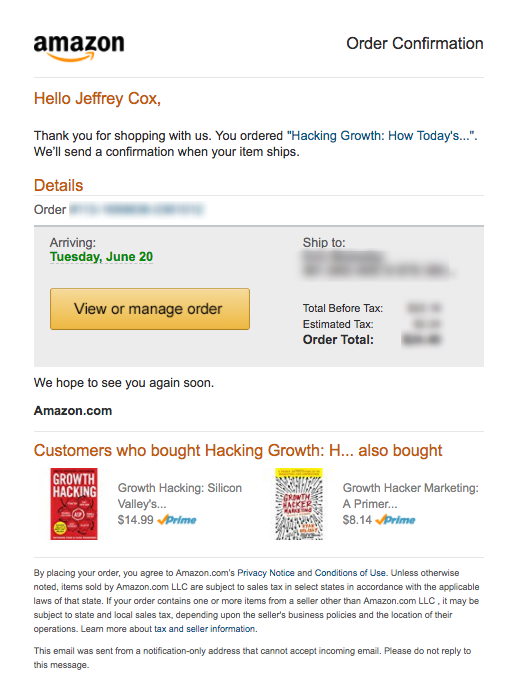

As you can see in the example above, Amazon is recommending books that are similar in content to the one that was purchased in the order confirmation.
Suggesting similar products to encourage customers to come back for more is a great strategy. So, how can can you set that up?
Well, there are two ways to go about it.
This first is to integrate dynamic content into your emails. This is more technical but easily managed with a tool that supports dynamic content. With Sendinblue you just have to create the logic and parameters using the templating language.
The other (much simpler) solution is to include a static call-to-action for a product or offer that you are trying to highlight at the time the email is being sent.
While this isn’t as personalized or dynamic, it’s much easier to implement for beginners and can still improve sales significantly — without any additional investment in resources.
Additional information and added value
Transactional emails don’t have to be boring!
There are several ways to make them more engaging and interesting: adding extra “bonus” content or advice, promo codes, or special offers instead of just providing the expected information.
Take for example the email receipts that Uber sends customers after each ride:
This message includes:
- A ride summary: start and end address, date, time, and a map of the route
- A chance to review the driver
- A chance to give a tip
- A CTA to download the UberEATs app
- An invitation to sign up for the Uber credit card
- Social media CTAs
This perfectly illustrates how much value you can get from leveraging the underutilized real estate in your transactional emails.
In Sum…
Hopefully, this guide helped clear up any confusion about the role of transactional emails and the business opportunities they present.
Now’s your chance to start leveraging transactional emails to get the greatest possible value and continue building positive customer relationships.
Are you looking for a reliable transactional email service solution? Try Sendinblue free to send up to 300 emails per day, or find the paid account that best fits your sending needs.
For more content like this, subscribe to our newsletter or follow us on Twitter.
 Deutsch
Deutsch









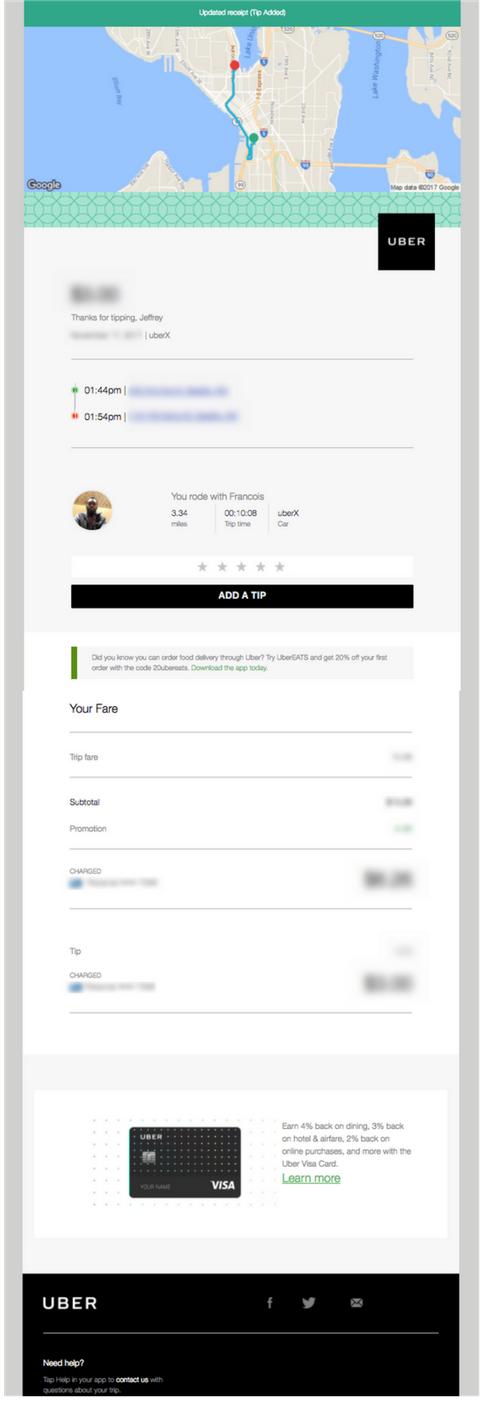













Comments
Hello,
I want to use SendInBlue to send transactional emails like “abandoned cart”, “product introduction” etc. but there is no option of how to send emails which have differing/generated elements in the content.
Say for example that my client buys product A, and I want to send them am email which corresponds to product A. and If they buy multiple products (A,B,C) then I want to send them email X.
I am unable to find anything in your documentation to help me do that.
Or if a client leaves the store and leaves product A and B in the cart, then I can´t seem to find a way to display the products A and B in the email.
Please help me
Hi Robin,
If you are trying to send completely different email templates depending on the products purchased or abandoned, you would need to work with a developer to send these using the API. If you just want to populate the same email template with different product information, you can do this directly in the template. This article talks about how to do it with a WooCommerce framework –> https://blog.sendinblue.com/how-to-customize-woocommerce-emails/.
Generally, transactional emails are sent automatically from your website and they are triggered by specific actions. For this reason, they are usually implemented using the API (using code on the back end of your website). Sendinblue is an SMTP relay, which means you can use our sending framework to route your transactional emails programmatically through our system, but it requires either code that is integrated directly with your website or through the use of certain ecommerce plugins like the Sendinblue plugin for WooCommerce.
Please describe some best practices that’ll help me to create brilliant and lovable transactional emails, that never cease to amaze. Apart from this This is a really good read for me. Thanks for posting this informative blog.
An eternally asked question: purchase on one page or in a few steps.
Useful information for the ones who want to know and implement regarding Transnational emails! Cheers.
Ready to find your marketing zen?
Take the stress out of your work day with a solution that’s built for you!
Get started free